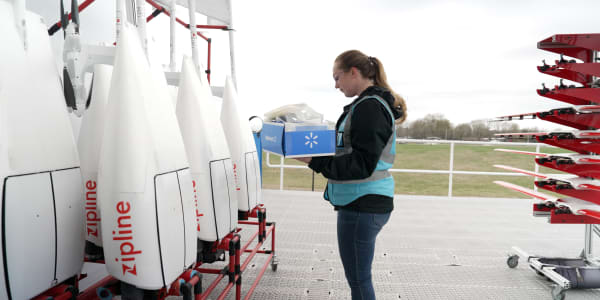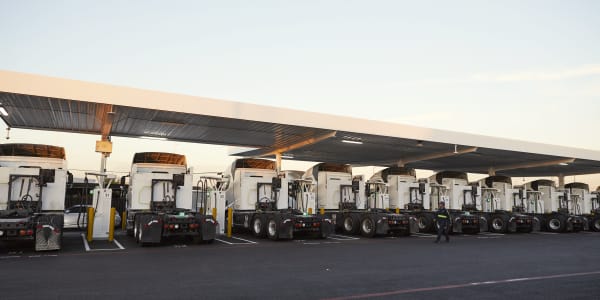The new age of convenience
Disruptive technology is one of those buzzwords that's easy to throw around, but it can sometimes be a little harder to see in our day-to-day lives. Technology advances and morphs so quickly that it's hard to tell what's on the verge of making a real difference and what's just a flash in the pan.
History, ultimately, is the real arbiter of what is disruptive and what isn't. But there are some breakthroughs that are obviously destined to make an impact — just like Google, Facebook and cell phones did in the past. Here are a few current and up-and-coming technologies that could ultimately change how you live your day-to-day life.
—By Chris Morris, special to CNBC.com
Posted 17 October 2015
Amazon Dash Button ($4.99)
We as a society are constantly on the go, so anything that can save even a few minutes is bound to grab people's attention. Amazon may have found the perfect intersection of convenience and time savings with Dash Button, a fob that connects to your home Wi-Fi network and works directly with your Amazon Prime account.
With the Dash Button, Prime members can reorder commonly used goods, including laundry detergent, diapers, grocery staples and pet food, at the press of a button (one button per product).
It not only ensures you don't run out of coffee, it creates a recurring revenue source for Amazon.
Starbucks Mobile Order & Pay App (free)
Spending time in line at Starbucks is something many commuters have already built into their day, but now it's possible to reclaim those 5 to 15 minutes (or more, if you're regularly refueling throughout the day). That could make you more productive, or it could let you sleep in a bit longer.
Last December the company launched the pilot program for the app, which lets you place your order in advance and have the coffee waiting for you when you arrive at the store. Since then, it has expanded to more than 4,000 stores. It should be nationwide by the end of the year.
Venmo (free)
We've all loaned a few bucks to a friend from time to time, but we don't always get that money back. Venmo is a PayPal–owned app that lets friends quickly and securely transfer money from a bank account or debit card to you (or vice versa) when they're cash poor. The recipient can then either transfer that balance to their own account or use it to reimburse other friends for whatever they might owe for pizza, movie tickets or whatever day-to-day expenses crop up.
In 2014, PayPal reported that Venmo had processed $2.4 billion for the full year. In the second quarter of this year, Venmo handled $1.6 billion in transactions.
Sling TV (starts at $20 a month)
Television has been edging away from the couch for a while now, but Dish Network was the first to truly cut the cord. Sling TV lets people watch live and on-demand programs anywhere via their tablet or phone for a base price of $20 per month (with no accompanying cable or satellite service required).
It got off to a good start with 169,000 customers in the first quarter of 2015, but Dish hasn't given an update since then. In the meantime, competition is coming, with both Apple and Amazon said to be exploring a similar model.
Amazon Echo ($180)
Digital assistants have long since taken over our smartphones, and Microsoft is bringing them to our PCs with the addition of Cortana in Windows 10. Now Amazon wants every home to have its own electronic assistant.
Echo is a smart speaker that is in constant listen mode and can answer questions (like the forecast, sports scores, word definitions, etc.). It can also sync with smart home devices, letting you control electronics in other parts of the home without marching up or down stairs. Amazon has regularly been adding features to the system since its launch and says it plans to continue doing so.
Apple Pay (free)
While Apple Pay hasn't caught on as quickly as many experts had expected, they say the idea of a mobile wallet is still likely to take hold as more retailers accept these sorts of payments. (Starbucks, KFC and Chili's are coming on board in 2016. Some 700,000 stories across the U.S. already support it, triple the number of locations since when it started last September.)
Gone are the days of digging around for exact change or swiping a card and hoping the magnetic strip isn't damaged. The convenience of touch and go will likely prove too alluring to consumers whether via Apple's system or one by another third party.
Uber (cost varies)
Arguably one of the most disruptive technologies affecting people's activities in years, ridesharing service Uber (along with its chief competitor Lyft) has transformed how people get around, giving them a cleaner, more comfortable option than taxis — at prices substantially below town car services.
The company has a market cap of more than $50 billion, and the private-car industry is going through some growing pains as some drivers demand more benefits and some cities question its screening methods. But riders continue to electronically hail the cars and aren't showing any signs of slowing down.
3D printing ($150 and up)
3D printing is still in the formative stages — and it may seem more like a novelty at present than a game-changer, but advocates say the potential is exciting. The technology could enable you to print a copy of items you need (to a limited extent, of course) at home. That could be anything — from keys to toys to small pieces of furniture.
Creating them will be as simple as downloading a pattern and hitting Print. And as prices on the technology drop, shipments of 3D printers, which now start at $150, are expected to double every year between 2016 and 2019 to reach more than 5.6 million, according to Gartner.
Cloud Storage (cost varies)
There may be no clearer sign that cloud storage is a now-critical component of day-to-day life than Dell's recent $67 billion buyout of EMC. Dropbox, meanwhile, has more than 300 million users. Microsoft's OneDrive boasts more than 250 million, and the company is aiming to reach $20 billion in annual cloud revenue by 2018.
For most users, though, the cloud has become a comforting layer of security that ensures that even if they lose their phone or their PC suffers a sudden, catastrophic failure, their pictures, documents and other data will still be safe and accessible.
Wearable fitness devices (cost varies)
While there was no shortage of interest in physical fitness before wearable devices hit the market, people weren't quite as numbers-obsessed with it. The market for calorie and step trackers continues to explode, topping $1 billion in 2014 as people look for ways to track their daily exercise or search for motivation to get off the couch.
Radiant Insights predicts that by 2021, the market for fitness-related wearables will top $14.9 billion. And research firm IDC said global wearable-device shipments will reach 76.1 million units in 2015 — a 163.6 percent improvement over 2014.
Correction:
This story was updated to reflect that Radiant Insights predicts the market for fitness-related wearables will top $14.9 billion by 2021.






